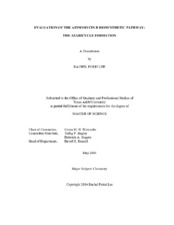| dc.description.abstract | Azinomycin B is an antitumor agent isolated from the soil bacteria Streptomyces sahachiroi. The complex molecular structure of azinomycin B contains a bioactive aziridine ring and an epoxide moiety, which are the major structural components responsible for the natural product’s antitumor bioactivity. In this study, we attempt to characterize the early steps of azinomycin B’s aziridine-containing azabicycle fragment biosynthesis and subsequently further elaborate on our existing knowledge on the overall biosynthesis of azinomycin B.
Previous attempt to characterize AziC2 suggested that the first step of azinomycin B’s azabicycle fragment formation involves the transfer of L-glutamate, the amino-acid precursor, to downstream biosynthetic enzymes through the catalytic activity of a putative N-acetyltransferase (AziC2), which utilizes acetyl-CoA as a feasible acetyl group donor. Interestingly, by closely examining the azinomycin B’s biosynthetic gene cluster and related homologs, we identified a previously uncharacterized protein AziW that may acts as an alternative acetyl group donor for AziC2. In addition, BLAST studies had proposed that AziC2 might potentially confer unrevealed phosphatase activity and function in conjunction with the novel AziW during the biosynthesis of azinomycin B’s azabicyclic moiety. To characterize the relationship between AziC2 and AziW, we performed radiolabeled feeding studies. The result from these labeling experiments indicated that the C-terminal of AziW is independently phosphorylated via self-activation in the presence of ATP. Most importantly, this phosphorylation event occurs prior to the transfer of L-glutamate by AziC2. These findings suggest that AziC2 only acts an acetyltransferase but not as a phosphatase towards AziW during the biosynthesis of azinomycin B’s azabicycle fragment. In addition, our labeling experiments and feeding studies also confirmed the functions of AziC3 and AziC4 as kinase and reductase respectively. This dissertation also includes our ongoing progress with AziH1, AziH2 and AziH3 which are responsible for the formation of the aziridine ring. The potential interaction between AziW and its enzymatic partners may offer advanced insights on the regulation mechanism involved in the biosynthesis of azinomycin B and help decipher the complex enzymology that highlights the biosynthesis of related natural products. | en |


